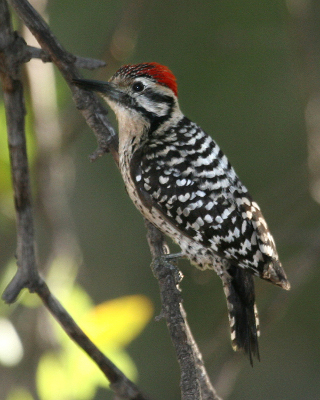Ladder-Backed Woodpecker
Category: Woodpeckers

Facts about Ladder-Backed Woodpeckers, "Scientific name for Ladder-Backed Woodpecker is Picoides scalaris". Ladder-Backed Woodpecker is a Picoides type woodpecker. Scientific name for Woodpecker "Picidae". Ladder-Backed Woodpeckers are birds in the Class of "Aves".
The Ladder-Backed Woodpeckers are native to Mexico and the southwestern parts of the United States, and they forage and nest in cactus. The Ladder-Backed Woodpecker are largely found in arid, brushy regions and thickets, and their preferred dwelling places include cottonwood groves, wooded canyons, oak and pine forests, desert scrubs and grasslands dictated by mesquite. The Ladder-Backed Woodpeckers are also called as the Cactus Woodpecker. Even though the bird is restricted to arid and desert environments in America, it can also be seen in the Pinelands in Central America. The Ladder-Backed Woodpecker is not considered to be experiencing any immediate threats or hazards to its range or population.
Ladder-Backed Woodpeckers have zygodactyl feet, having 4 fingers, which means they have two toes facing the front and two toes facing the back, that helps them to have a strong grip on trees vertically. The Ladder-Backed Woodpecker use these 8 fingers with their stiff central portion tail feathers to brace on trees as they climb.
Male and female Ladder-Backed Woodpeckers are able to drum hollow trees logs execrate. Since Ladder-Backed Woodpeckers do not have vocal cords and don't sing, this pecking activity also plays an important role in communicating with each other. Ladder-Backed Woodpeckers drumming is also to attract a mate, mark out territory, both sexes are known to drum.
Features
The Ladder-backed Woodpecker is a small-sized bird, with a body length, ranging from 6.3 inches to 7.1 inches (16 to 7.1 cm), with the wingspan that ranges from 11 inches to 12 inches (28 to 30.4 cm). They have a body mass that ranges from 0.7 pounds to 1.7 pounds (.31 to .77 kg).
The woodpecker has a combination of black, gray and white color body, with buff-gray color underparts with black color spotting, and black and white barred upperparts. The Ladder-Backed Woodpecker has a branded or barred back pattern, with a striped breast and a spotted abdomen. The all-purpose bill of the Ladder-Backed Woodpecker is in the shape of a dagger. The eyes of the Ladder-Backed Woodpecker are gray-brown or brown in color during hatch after that, they turn to red color when matured. The Ladder-Backed Woodpecker have a unique pattern of capped head, with mala line, with a red color crown. The Ladder-Backed Woodpeckers appear with black color forehead and nape, with a buff-gray throat. Juveniles of both genders have a red color crown and their red feathering is less extensive than on a matured male woodpecker.
When the Ladder-backed Woodpecker soars, the bird will quickly flap its wings. During flying, the shallow flapping swaps with short gliding periods. The Ladder-Backed Woodpeckers do not dig as much as other woodpecker varieties do for their food; instead, they probe, tap and pry off bark at the time of foraging. The consumption of timber-boring beetles and other unhelpful insects by the Ladder-Backed Woodpeckers assists in the control of pest populations, so rescuing several trees from infection.
Diet
Mostly, Ladder-backed Woodpeckers feed on cactus fruits, sunflower seed, suet, sugar water, nuts and insects, and they forages on trunks and the branches of a tree, and occasionally they forage on the ground.
There are more than 190 species of woodpeckers worldwide, but none of them are found in polar regions, Madagascar, New Zealand or Australia.
Ladder-Backed Woodpeckers tongue is up to 4 inches (10.16 cm) long. The length can be a little different depending on which species of woodpecker. The Ladder-Backed Woodpeckers tongue wraps around the reinforced skull structured and squashy bone, to even out the impact of the pecking force. Many Ladder-Backed Woodpeckers have barbed tongues that helps them remove bugs from holes and tree bark.
Feathers that look like hairs on the Ladder-Backed Woodpecker nostrils, prevent ingestion of wood particles.
The average life span of a Ladder-Backed Woodpecker in the wild is 4 to 11 years, depending on the species and environment
Ladder-Backed Woodpeckers are omnivores; meaning - an animal that eats food of both animal and plant and origin.
Ladder-Backed Woodpeckers are monogamous meaning- the pair will mate for lifetime. Both male and female prepare the nest in the tree for babies and both will help feed them. The female Ladder-Backed Woodpecker will lay between 3 and 5 eggs and the incubation period will lasts 11 to 14 days. After one month of hatching, young Ladder-Backed Woodpeckers will leave the nest and venture out on there own.
Ladder-Backed Woodpeckers possess a protective ocular mechanisms for protecting its eyes from shaking from the pecking impact. woodpeckers show a restricted axial globe movement due to the tight fit within the fascial tissue connections and orbit between the sclera and orbital rim.
The eyes of the Ladder-Backed Woodpecker are covered with a nictitating membrane (from Latin nictare, to blink)— a translucent and transparent third eyelid - that protects the Ladder-Backed Woodpeckers eyes from flying debris while pecking.
When feeding, drumming and building a nest cavity, a Ladder-Backed Woodpecker can peck up to 20 times per second, wow that's fast! or a total between 9,000 and 12,000 pecks in a day.
Ladder-Backed Woodpeckers have a prominent surge in flight comprise of three rapid wing flaps, followed by a quick glide when the Ladder-Backed Woodpeckers wings are tucked against its body rather than spread out like many other birds.

 Back To Category Woodpeckers
Back To Category Woodpeckers